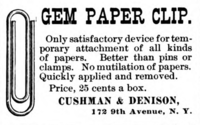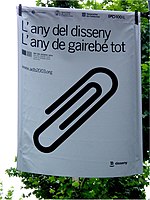Paper clip
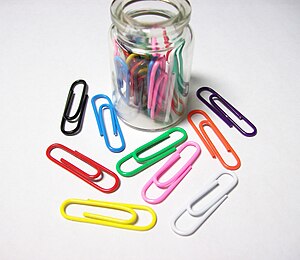

A paper clip (or paperclip) is a tool used to hold sheets of paper together, usually made of steel wire bent to a looped shape (though some are covered in plastic). Most paper clips are variations of the Gem type introduced in the 1890s or earlier, characterized by the one and a half loops made by the wire. Common to paper clips proper is their utilization of torsion and elasticity in the wire, and friction between wire and paper. When a moderate number of sheets are inserted between the two "tongues" of the clip, the tongues will be forced apart and cause torsion in the bend of the wire to grip the sheets together. They are usually used to bind papers together for productivity and portability.
The paper clip's widespread use in various settings, from offices to educational institutions, underscores its functional design and adaptability. While primarily designed for binding papers, its versatility has led to a range of applications, both practical and creative.
Shape and composition
Paper clips usually have an oblong shape with straight sides, but may also be triangular or circular, or have more elaborate shapes. The most common material is steel or some other metal, but molded plastic is also used. Some other kinds of paper clips use a two-piece clamping system. Recent innovations include multi-colored plastic-coated paper clips and spring-fastened binder clips.[1] To provide a perspective on the metal content, considering the average iron content in humans, the combined iron in the human population could theoretically produce several hundred million paperclips, given a typical paper clip's weight of 1 gram.
History
According to the Early Office Museum, the first patent for a bent wire paper clip was awarded in the United States to Samuel B. Fay in 1867.[2] This clip was originally intended primarily for attaching tickets to fabric, although the patent recognized that it could be used to attach papers together.[3] Fay received U.S. patent 64,088 on April 23, 1867. Although functional and practical, Fay's design along with the 50 other designs patented prior to 1899 are not considered reminiscent of the modern paperclip design known today.[4] Another notable paper clip design was also patented in the United States by Erlman J. Wright on July 24, 1877, patent #193,389. This clip was advertised at that time for use in fastening together loose leaves of papers, documents, periodicals, newspapers etc.[3]
The most common type of wire paper clip still in use, the Gem paper clip, was never patented, but it was most likely in production in Britain in the early 1870s by "The Gem Manufacturing Company", according to the American expert on technological innovations, Professor Henry J. Petroski.[5] He refers to an 1883 article about "Gem Paper-Fasteners", praising them for being "better than ordinary pins" for "binding together papers on the same subject, a bundle of letters, or pages of a manuscript".[6] Since the 1883 article had no illustration of this early "Gem", it may have been different from modern paper clips of that name.
The earliest illustration of its current form is in an 1893 advertisement for the "Gem Paper Clip".
Definite proof that the modern type of paper clip was well known in 1899 at the latest, is the patent granted to William Middlebrook of Waterbury, Connecticut on April 27 of that year for a "Machine for making wire paper clips." The drawing clearly shows that the product is a perfect clip of the Gem type.[10][11] The fact that Middlebrook did not mention it by name, suggests that it was already well known at the time. Since then countless variations on the same theme have been patented. Some have pointed instead of rounded ends, some have the end of one loop bent slightly to make it easier to insert sheets of paper, and some have wires with undulations or barbs to get a better grip. In addition, purely aesthetic variants have been patented, clips with triangular, star, or round shapes.[12] But the original Gem type has for more than a hundred years proved to be the most practical, and consequently by far the most popular. Its qualities—ease of use, gripping without tearing, and storing without tangling—have been difficult to improve upon. National Paperclip Day is May 29.[13]
The Gem-type paperclip has become a symbol of inventive design, as confirmed below – although falsely – by its celebration as a Norwegian invention in 1899. More convincing is its appropriation as logo of the Year of Design (L'any del disseny) in Barcelona 2003, depicted on posters, T-shirts and other merchandise.
-
Small metal paper clip, with measure in centimetres
-
Assorted paperclip shapes, sizes, and designs
-
Middlebrook 1899 patent for a paper clip machine showing that the Gem was already in common use (top and bottom)
-
GEM Paper Clip advertisement, Jan 1893, by Cushman & Denison
-
Paper clip icon on poster advertising the Year of Design in Barcelona 2003
Unsupported claims
It has been claimed that the paper clip was invented by English intellectual Herbert Spencer (1820–1903).[14][15][16] Spencer registered a "binding-pin" on 2 September 1846,[17][18] which was made and sold by Adolphus Ackermann for over a year,[19] advertised as "for holding loose manuscripts, sermons, weekly papers, and all unstitched publications".[17] Spencer's design, approximately 15 cm (5.9 in) unfolded, looked more like a modern cotter pin than a modern paper clip.[17]
Norwegian claim
This section may benefit from being shortened by the use of summary style. |
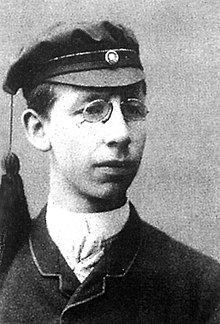
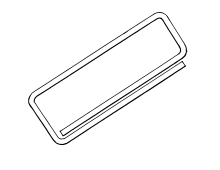
Norwegian Johan Vaaler (1866–1910) has been identified as the inventor of the paper clip. He was granted patents in Germany[20] and in the United States[21] (1901) for a paper clip of similar design, but less functional and practical, because it was more complicated to insert into the paper Vaaler probably did not know that a better product was already on the market, although not yet in Norway. His version was never manufactured and never marketed, because the superior Gem was already available.
Long after Vaaler's death his countrymen created a national myth based on the false assumption that the paper clip was invented by an unrecognized Norwegian genius. Norwegian dictionaries since the 1950s have mentioned Vaaler as the inventor of the paper clip,[22] and that myth later found its way into international dictionaries and much of the international literature on paper clips.
Vaaler probably succeeded in having his design patented abroad, despite the previous existence of more useful paper clips, because patent authorities at that time were quite liberal and rewarded any marginal modification of existing inventions.[23] Johan Vaaler began working for Alfred J. Bryns Patentkontor in Kristiania in 1892 and was later promoted to office manager, a position he held until his death.[24] As the employee of a patent office, he could easily have obtained a patent in Norway. His reasons for applying abroad are not known; it is possible that he wanted to secure the commercial rights internationally. Also, he may have been aware that a Norwegian manufacturer would find it difficult to introduce a new invention abroad, starting from the small home market.
Vaaler's patents expired quietly, while the "Gem" was used worldwide, including his own country. The failure of his design was its impracticality. Without the two full loops of the fully developed paper clip, it was difficult to insert sheets of paper into his clip. One could manipulate the end of the inner wire so that it could receive the sheet, but the outer wire was a dead end because it could not exploit the torsion principle. The clip would instead stand out like a keel, perpendicular to the sheet of paper. The impracticality of Vaaler's design may easily be demonstrated by cutting off the last outer loop and one long side from a regular Gem clip.
National symbol
The originator of the Norwegian paper clip myth was an engineer of the Norwegian national patent agency who visited Germany in the 1920s to register Norwegian patents in that country. He came across Vaaler's patent, but failed to detect that it was not the same as the then-common Gem-type clip.[25] In the report of the first fifty years of the patent agency, he wrote an article in which he proclaimed Vaaler to be the inventor of the common paper clip.[26] This piece of information found its way into some Norwegian encyclopedias after World War II.
Events of that war contributed greatly to the mythical status of the paper clip. Patriots wore them in their lapels as a symbol of
The leading Norwegian encyclopedia mentioned the role of the paper clip as a symbol of resistance in a supplementary volume in 1952, but did not yet proclaim it a Norwegian invention.[28] That information was added in later editions. According to the 1974 edition, the idea of using the paper clip to denote resistance originated in France. A clip worn on a lapel or front pocket could be seen as "deux gaules" (two posts or poles) and be interpreted as a reference to the leader of the French Resistance, General Charles de Gaulle.[29]
The post-war years saw a widespread consolidation of the paper clip as a national symbol. Authors of books and articles on the history of Norwegian technology eagerly seized it to make a thin story more substantial. They chose to overlook the fact that Vaaler's clip was not the same as the fully developed Gem-type clip.[30] In 1989 a giant paper clip, almost 7 m (23 ft) high, was erected on the campus of a commercial college near Oslo in honor of Vaaler, ninety years after his invention was patented. But this monument shows a Gem-type clip, not the one patented by Vaaler. The celebration of the alleged Norwegian origin of the paper clip culminated in 1999, one hundred years after Vaaler submitted his application for a German patent. A commemorative stamp was issued that year, the first in a series to draw attention to Norwegian inventiveness. The background shows a facsimile of the German "Patentschrift". However, the figure in the foreground is not the paper clip depicted on that document, but the much better known "Gem". In 2005, the national biographical encyclopedia of Norway (Norsk biografisk leksikon) published the biography of Johan Vaaler, stating he was the inventor of the paper clip.[31]
-
The giant paper clip in Sandvika, Norway. It shows the Gem, not the one patented by Vaaler.
-
Postage stamp issued in 1999 to commemorate Vaaler's paper clip. In the background his German "Patenschrift". 1901. The depicted paper clip is not the one he invented, but the successful Gem clip.
Other uses
Wire is versatile in its nature. Thus a paper clip is a useful accessory in many kinds of mechanical work, including computer work: the metal wire can be unfolded with a little force. Several devices call for a very thin rod to push a recessed button which the user might only rarely need. This is seen on most
Another common use of paper clips is Cannabis smokers use straightened out paper clips to unclog their pipe or bong bowl.
Another creative use of paper clips is in "paperclip art", where enthusiasts bend and twist paper clips into intricate designs and figures, ranging from simple shapes to detailed sculptures. This form of art showcases the flexibility and adaptability of the paper clip beyond its traditional use.
Additionally, paper clips can serve as temporary bookmarks in books or documents. Their slim profile and easy placement make them useful for marking a specific page or section without causing damage or adding bulk.
Paper clips can be bent into a crude but sometimes effective lock picking device.[33] Some types of handcuffs can be unfastened using paper clips. There are two approaches. The first one is to unfold the clip in a line and then twist the end in a right angle, trying to imitate a key and using it to lift the lock fixator. The second approach, which is more feasible but needs some practice, is to use the semi-unfolded clip kink for lifting when the clip is inserted through the hole where the handcuffs are closed.[citation needed]
A paper clip image is the standard image for an attachment in an email client.[34]
Trade
In 1994, the United States imposed anti-dumping tariffs against China on paper clips.[35]
Other fastening devices
See also
- Clippy– an anthropomorphic paper clip assistant in Microsoft Office
- Universal Paperclips - a game based on a thought experiment where the user plays the role of an AI programmed to produce paperclips
- Operation Paperclip
- Holocaustby collecting 6,000,000 (and more) physical objects, deciding to collect paperclips because of their small size and easy availability
Notes
- ^ Brown, Peter (September 1, 2009). "The Paper Clip". Scientific American. Retrieved December 12, 2018.
- ^ Grace, Valerie (December 28, 2003). "Get a grip: Popularity of paper clips continue through the years". The Times Recorder (Zanesville, Ohio, U.S.). p. D1.
- ^ a b "History of the Paper Clip". Early Office Museum.
- ^ "Paper Clip". The Great Idea Finder. Archived from the original on 2016-11-14. Retrieved 2010-07-20.
- ^ Petroski, Henry: "Polishing the Gem: A First-Year Design Project", Journal of Engineering Education, October 1998, p. 445
- ^ Penn, Arthur: The Home Library, Appleton, New York, 1883
- . Retrieved 11 February 2019.
- ^ a b History of the Paper Clip. Ad from Cushman & Denison, in The American Lawyer, Sept 1893, p. 3.
- ^ "Cushman & Denison advertisement". The American Lawyer. 1 (9): 3. September 1893. Retrieved 9 February 2019.
- ISBN 978-0-307-77305-0.; "From Pins to Paper Clips"
- ISBN 978-0-674-46368-4.; "Paper Clips and Design"
- S2CID 111237529. Appendix: A selected list of U.S. Patents for paper clips. Journal of Engineering Education, 1998, p. 449.
- ^ Armstrong, Cassie (29 May 2018). "National Paperclip Day: How to celebrate in Central Florida". orlandosentinel.com.
- JSTOR 3119625.
- ISBN 978-0-571-27378-2.
- ISSN 0191-3557. Retrieved 30 September 2021.
he often assured beginning graduate students that Herbert Spencer's greatest contribution to humanity had been the invention of the paper clip
- ^ a b c Spencer, Herbert (1904). An Autobiography. D. Appleton. pp. 352–354, 639–640.
- ^ "Useful Registered Design Number: 809". BT 45 — Patents, Designs and Trade Marks Office: Non-ornamental ('Useful') Designs Act 1843 Representations. London: National Archives. 2 September 1846. Retrieved 30 September 2021.
- ^ Son of Rudolph Ackermann; see Spencer (1904) p.354 "Mr. Ackermann who was a bad man of business, and who, failing not long afterwards, shot himself"; and "Rudolph Ackermann". British artists' suppliers, 1650-1950. National Portrait Gallery. Retrieved 29 September 2021.
Adolphus Ackermann also set up business close by at 15 Beaufort Buildings but committed suicide in 1858 when faced with bankruptcy proceedings
- ^ Application dated 12 November 1899, Patentschrift no. 121067, patent granted 6 June 1901.
- ^ US Patent No. 675,761 June 4, 1901.
- ^ "Binders" Aschehougs konversasjonsleksikon, Oslo 1975, vol. 2, p. 695.
- ^ Petroski, Henry "The Evolution of Artifacts", American Scientist, Volume 80, 1992, pp. 416–20.
- ^ Holst, Wilhelm: "Johan Vaaler", Studenterne fra 1887, Kristiania 1912.
- ^ Vaaler's forgotten German patent was found by patent engineer Halvard Foss of The Norwegian Industrial Property Office (Patentstyret) while looking for patents granted to Norwegians in the German patent office. "I made this discovery known to my colleagues", Foss stated in an interview with the weekly A-magasinet no. 52, 1988.
- ^ Foss, Halvard: "Den frittstående oppfinner", Styret for det industrielle rettsvern 50 år, Oslo 1961, p. 190.
- ISBN 82-509-3249-8.
- ^ Aschehougs konversasjonsleksikon, supplementsbind, Oslo 1952.
- ^ Aschehougs konversasjonsleksikon, Oslo 1974, Vol. 2, p. 695.
- ^ Hesstvedt, Ola: "Den lille norske hjelperen fyller 90 år", A-magasinet nr. 52, 1988.
- ISBN 82-573-1011-5.
- ^ Osdol, Paul Van (1 September 2015). "Pittsburgh dentist admits using paper clips for root canals". Retrieved 22 January 2018.
- ISBN 978-1440560927.
- ISBN 9781921134555.
- ^ Paper Clips from China (PDF). US International Trade Commission.
Further reading
- Henry Petroski (1992). The Evolution of Useful Things. New York: Knopf. ISBN 0-679-74039-2.
- James Ward (2015). The Perfection of the Paper Clip: Curious Tales of Invention, Accidental Genius, and Stationery Obsession. Simon and Schuster. ISBN 9781476799865.
External links
Patents
- US3,057,027—Paper clip—E. P. Bugge




